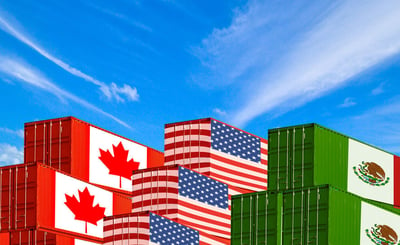USMCA/CUSMA in-force as of July 1, 2020
The new North American free trade agreement (known as USMCA/CUSMA/T-MEC) is now being enforced.
The Customs authorities of all three member countries (Canada, U.S., Mexico) are now tasked with interpreting and applying the rules of origin and the origin procedures of the agreement. To do so, they will use the Uniform Regulations agreed upon by all three countries.
So, what does this mean for you? In general, it means that you now need to comply with all the new rules and procedures of USMCA/CUSMA.
 Changes from NAFTA
Changes from NAFTA
- Unlike NAFTA, USMCA/CUSMA is set to be renewed every six years. It has a sunset clause in 16 years, at which point the member countries will determine if they want to continue with the agreement.
- Also new: the exporter, producer, and/or the importer can produce certifications of origin.
- There is no formal document or format for origin certification. What is required is information satisfying the minimum data elements of Annex 5-A and the Uniform Regulations.
- The refund window has been extended in Canada to 4 years from 1 year. In the U.S., the window remains one year.
Please remember: just because a good is made in North America, doesn’t mean it automatically qualifies as duty-free. You must prove origin with documented evidence.
Certification means:
- A valid origin statement using the minimum data elements from Annex 5-A
On the compliance side, this means:
- Correct Harmonized System (HS) classification
- Accurate utilization of the rules of origin outlined in the agreement
- Comprehensive record-keeping
- Validation/verification
Rules of origin
Please note:
- There is no single generic rule for manufactured goods
- The Regional Value Content (RVC) threshold can vary depending on the good
The rules of origin cover not only finished goods, but manufacturing materials that make up those goods. Some examples of the rules:
Article 4.2(a): Wholly obtained or produced goods
These include goods like minerals, plants, animals, fish, or goods produced exclusively from these goods.
Article 4.2(b): Product-specific rules of origin
Non-originating materials must satisfy rules about:
- Substantial Transformation (Tariff Shift), ie. ore from China transformed in North America into screws, and/or
- Regional Value Content (RVC), in which a certain percentage of the transaction value/net cost of the goods was produced in North America
Article 4.2(c): Produced entirely in the territory exclusively with originating materials
Like Article 4.2(a), but please note that documentary evidence is required to prove that every material meets the rules of origin
Certification of origin
As of midnight on June 30, 2020, NAFTA certificates or origin cannot be used. However, NAFTA COOs used previously can still be used to claim refunds within the refund window.
- Under USMCA/CUSMA, no formal document or format is required.
- You need to supply the minimum data elements from Annex 5-A either on a separate document or included in the invoice or packing lists.
- Cole has created a form based off the old NAFTA certificate.
- Refer to Article 5.2(3)(6), which outlines the minimum data elements form Annex 5-A, and Uniform Regulations origin procedures Chapter 5.
There is a waiver for low-value shipments coming into Canada. Shipments valued under $3,300 CAD do not need to be supported with certification of origin; but there are a couple of caveats:
- The shipment still needs to meet the rule of origin and the record keeping requirements.
- There’s a risk if you are audited and do not have proper documentary evidence of the origin of the goods/materials.
- Dividing a large shipment into several smaller shipments is not allowed.
Origin verifications
- Verifications are conducted by the Customs Authority in the importer’s country, with possible assistance from Customs in the exporter or producer’s country.
- They can be asked of the importer, exporter, or producer via written request, questionnaire or on-site visit.
- Customs will rely on the contact information of the certifier—if they cannot reach the certifier, they may automatically determine that the goods do not qualify.
- Customs will share verification results with the other countries’ authorities
- Verifications will be complete within 120 days after receiving all the information
- If multiple verifications reveal a “pattern of conduct” preferential treatment may be withdrawn
Enforcement collaboration
The three member countries work together to enforce the agreement.
They do this by sharing information—even confidential information—between Customs authorities. They provide each other with historical non-compliance evidence or other information.
Non-compliance will result in increased inspections and audits
Our Customs Consultants are ready to help you understand how the current USMCA/CUSMA rules of origin impact your products. Contact us today.
Understanding Free Trade. it's what we do.
Information provided by: Free Trade Dept. - Cole International

Latest Articles
- Watch out for these extra charges on your freight bill
- Key differences between duty drawbacks and duty refunds for importers
- Mitigating container shortages and rising shipping prices for ocean imports
- How Canadian importers benefit from end use tariff codes and conditional relief
- The benefits of operating as a Non-Resident Importer in Canada
